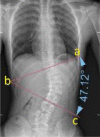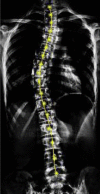A Novel Computer-Aided Method to Evaluate Scoliosis Curvature using Polynomial Math Function
- PMID: 31750265
- PMCID: PMC6820027
- DOI: 10.31661/jbpe.v0i0.1194
A Novel Computer-Aided Method to Evaluate Scoliosis Curvature using Polynomial Math Function
Abstract
Background: Scoliosis is a health problem that causes a side-to-side curvature in the spine. The curvature may have an "S" or "C" shape. To evaluate scoliosis, the Cobb angle has been commonly used. However, digital image processing allows the Cobb angle to be obtained easily and quickly, several researchers have determined that Cobb angle contains high variations (errors) in the measurements. Therefore, a more reproducible computer aided-method to evaluate scoliosis is presented.
Material and methods: In this analytical study, several polynomial curves were fitted to the spine curvature (4th to 8th order) of thirty plain films of scoliosis patients to obtain the Curvature-Length of the spine. Each plain film was evaluated by 3 physician observers. Curvature was measured twice using the Cobb method and the proposed Curvature-Length Technique (CLT). Data were analyzed by a paired-sample Student t-test and Pearson correlation method using SPSS Statistics 25.
Results: The curve of 7th order polynomial had the best fit on the spine curvature and was also used for our proposed method (CLT) obtaining a significant positive correlation when compared to Cobb measurements (r=0.863, P<0.001). The Intraclass Correlation (ICC) was between 0.863 and 0.948 for Cobb method and0.974 to 0.984 for CLT method. In addition, mean measurement of the inter-observer COV (Coefficient of Variation) for Cobb method was of 0.185, that was significantly greater than the obtained with CLT method of 0.155, this means that CLT method is 16.2% more repeatable than Cobb Method.
Conclusion: Based on results, it was concluded that CLT method is more reproducible than the Cobb method for measuring spinal curvature.
Keywords: Cobb-Angle; Methods; Polynomial; Spinal Curvatures; Scoliosis.
Copyright: © Shiraz University of Medical Sciences.
Conflict of interest statement
Conflict of Interest: None.
Figures









References
-
- Langensiepen S, Semler O, Sobottke R, Fricke O, Franklin J, Schonau E, et al. Measuring procedures to determine the Cobb angle in idiopathic scoliosis: a systematic review. Eur Spine J. 2013;22:2360–71. doi: 10.1007/s00586-013-2693-9. [ PMC Free Article] - DOI - PMC - PubMed
-
- Wu W, Liang J, Du Y, Tan X, Xiang X, Wang W, et al. Reliability and reproducibility analysis of the Cobb angle and assessing sagittal plane by computer-assisted and manual measurement tools. BMC Musculoskelet Disord. 2014;15:33. doi: 10.1186/1471-2474-15-33. [ PMC Free Article] - DOI - PMC - PubMed
-
- Ritter R, Nagasse Y, Ribeiro I, Yamazato C, Oliveira F M d, Kusabara R. Comparison of Cobb angle measurement in scoliosis by residents and spine experts. Coluna/Columna. 2016;15:13–6. doi: 10.1590/s1808-185120161501147274. - DOI
LinkOut - more resources
Full Text Sources
